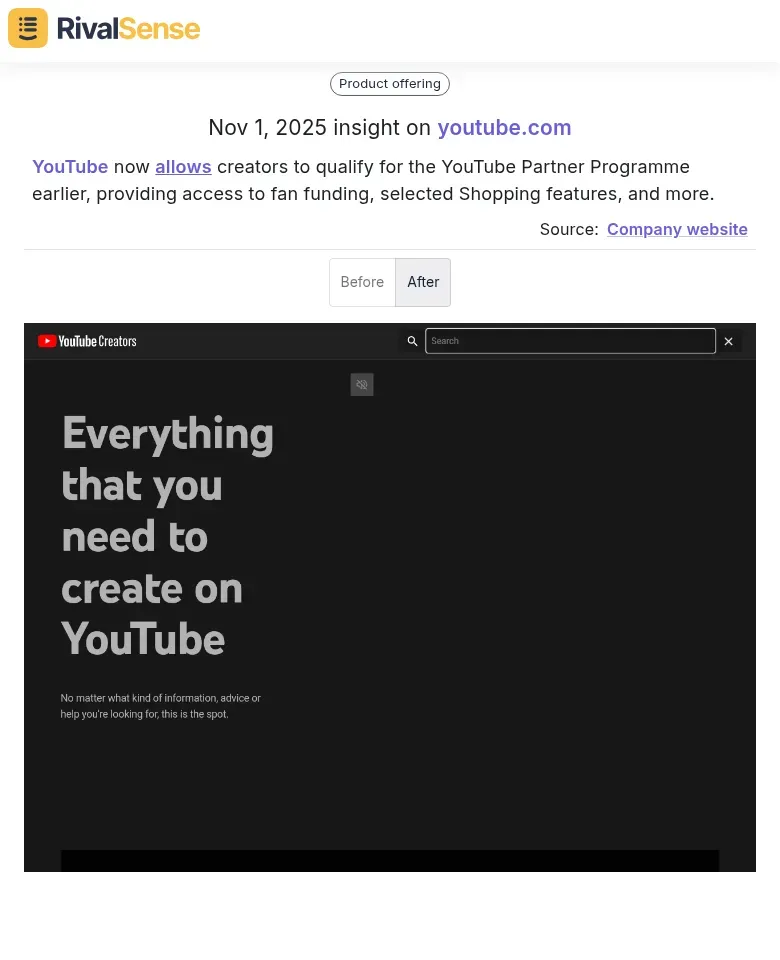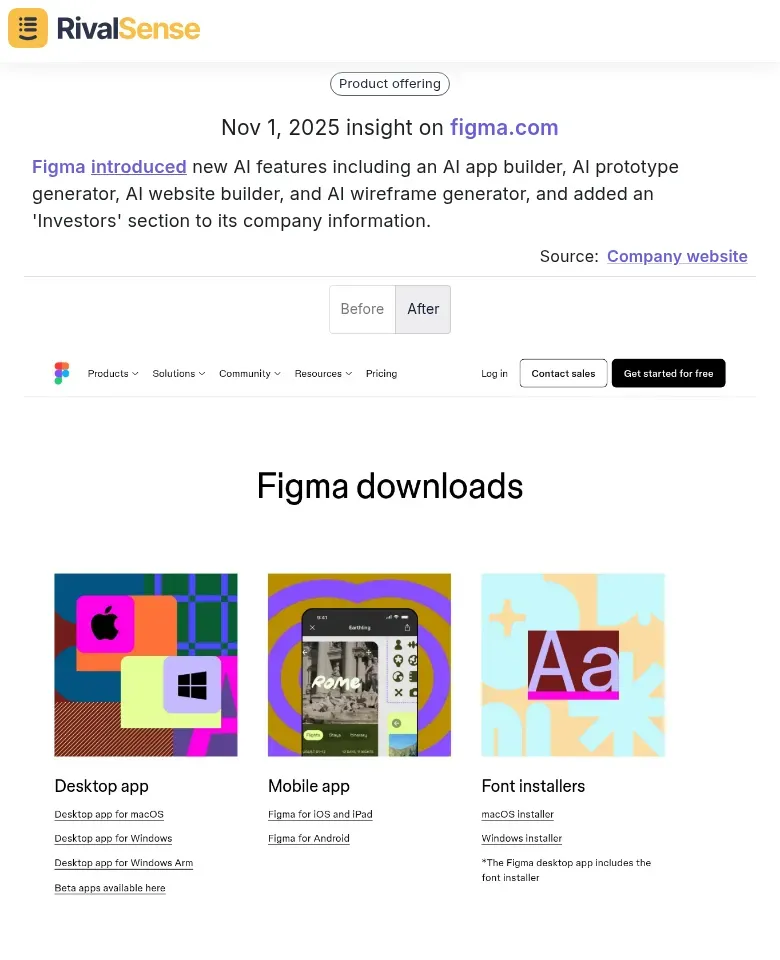Optimize Competitor Insights from Website Changes for Strategic Advantage
Monitoring competitor website changes in real-time offers early signals of strategic shifts, such as new product launches, pricing updates, or rebranding efforts. For example, a sudden homepage redesign might indicate a pivot in target audience or messaging, allowing you to anticipate market moves and stay ahead of trends. This proactive approach transforms raw data into actionable intelligence, giving you a competitive edge by enabling swift, informed decisions rather than reactive catch-up. By connecting these changes to broader trends—like rising customer expectations for personalization—you can align your strategies to capitalize on emerging opportunities.
Practical Steps:
- Set up automated alerts for key competitor pages using tools like RivalSense
- Track frequency and timing of updates to identify patterns
- Analyze changes in context with market reports for deeper insights
Checklist for Weekly Reviews:
- [ ] Review homepage layouts, CTAs, and navigation changes
- [ ] Map trends to your business goals
- [ ] Brief your team on key insights and potential actions
- [ ] Validate findings with external data sources
Product and Feature Updates: Decoding Innovation and Market Positioning
Understanding how competitors innovate is crucial for staying competitive in fast-moving markets. When they launch new features, it's essential to analyze them to decode their priorities and market positioning, as this reveals where they're investing and who they're targeting. For instance, if a rival adds AI-powered analytics, they're likely focusing on data-driven enterprises, while moving premium features to basic tiers could signal an expansion into SMB segments.
Take the example from RivalSense: YouTube now allows creators to qualify for the YouTube Partner Programme earlier, providing access to fan funding, selected Shopping features, and more. This type of insight is valuable because it highlights shifts in monetization and user engagement strategies, allowing you to anticipate changes in content creator ecosystems and adjust your own offerings.

Practical Steps:
- Create a feature tracking matrix comparing launch dates, target segments, and pricing tiers
- Monitor website navigation changes and new landing pages for positioning clues
- Set up alerts for 'What’s New' sections and release notes
- Analyze customer testimonials to identify ideal client profiles
- Review documentation updates for technical capability expansions
Checklist for Feature Analysis:
- [ ] Map feature launches to competitor’s strategic goals
- [ ] Identify which customer pain points new features address
- [ ] Note pricing model changes accompanying updates
- [ ] Track update frequency to gauge aggression in growth
- [ ] Compare your feature gaps against competitor innovations
💡 Tip: Use website heatmaps to see which new features get the most attention, revealing what customers value most.
Monetization and Partnership Strategy Shifts: Tracking Revenue Model Evolution
Keeping an eye on how competitors evolve their revenue models is key to anticipating market expansions and threats. Tracking monetization and partnership strategy shifts reveals critical clues about their target segments, geographic focus, and scalability testing. For example, a SaaS company adding an enterprise tier with custom integrations may be targeting larger clients, while introducing usage-based billing could indicate a move toward more flexible pricing.
Practical Steps:
- Set up alerts for pricing, partner, and program pages using automated tools
- Review these pages quarterly for structural shifts and new tiers
- Analyze early access programs to gauge demand for future offerings
Checklist for Monitoring Shifts:
- [ ] Look for new partnership levels or qualification changes
- [ ] Check if pricing has shifted to value-based tiers
- [ ] Identify evidence of pilot programs or beta tests
- [ ] Assess commission structure updates in partner programs
- [ ] Document changes in your competitive intelligence dashboard
By proactively tracking these elements, you can adjust your strategy to stay ahead in evolving competitive landscapes.
Organizational and Leadership Changes: Reading Between the Lines of Company Structure
Executive appointments and departmental restructurings often signal major strategic shifts within a company. Monitoring these changes helps you decode priorities, such as expansion into new markets or investments in specific technologies, giving you a heads-up on competitive moves. For instance, a new CMO might indicate a push in marketing, while a Chief AI Officer points to heavy tech investment.
Consider this RivalSense insight: Collins Aerospace updated its leadership team, adding Troy Brunk as President and several other executives including Drew Barber for Legal, Contracts & Compliance, Mona Bates for Digital Technology, and others in key roles. This type of insight is valuable because it reveals organizational focus areas—like digital transformation or compliance—allowing you to anticipate strategic initiatives and align your responses.

Practical Steps:
- Set up Google Alerts for competitor executive names and roles
- Review press releases and leadership page updates monthly
- Analyze executive backgrounds for patterns in previous companies
- Document changes in a leadership tracking spreadsheet
- Look for clusters of hires in specific functions over 3-6 month periods
Leadership Tracking Spreadsheet Columns:
| Name | Role | Date | Previous Company | Strategic Implications |
|---|---|---|---|---|
| Example | CMO | 2025-10-01 | Tech Giant | Marketing expansion |
Checklist for Analysis:
- [ ] Connect leadership changes to cultural or strategic shifts
- [ ] Monitor LinkedIn for executive posts about new directions
- [ ] Note reporting structure changes for team alignment clues
- [ ] Assess if hires indicate entry into new markets or technologies
- [ ] Update your competitive intelligence regularly
AI and Technology Integration: Spotting Digital Transformation Initiatives
Staying abreast of competitors' AI and tech integrations is essential in today's digital-first world. Monitoring their website changes can uncover adoption patterns, differentiation strategies, and overall digital maturity, helping you benchmark your own initiatives. For example, when a competitor adds real-time personalization or AI-driven recommendations, it signals advanced machine learning capabilities that could reshape market expectations.
Here's a real-world example from RivalSense: Figma introduced new AI features including an AI app builder, AI prototype generator, AI website builder, and AI wireframe generator, and added an 'Investors' section to its company information. This insight is valuable because it highlights how competitors leverage AI for product innovation and potentially attract investment, enabling you to assess if similar technologies could enhance your market positioning.

Recognize AI Adoption Patterns:
- Track new AI-powered features like chatbots or automated workflows
- Monitor job postings for AI/ML roles to detect emerging capabilities
- Use technographic tools to track stack changes and integrations
Analyze AI for Differentiation:
- Assess if AI is used for operational efficiency or product innovation
- Compare implementations against industry benchmarks
- Identify gaps and opportunities in your own strategy
Practical Checklist:
- [ ] Conduct weekly website audits for new tech features
- [ ] Monitor job boards for technical hiring patterns
- [ ] Use tools to track technology stack updates
- [ ] Analyze press releases for AI partnership announcements
- [ ] Benchmark against digital maturity frameworks
🚀 Focus on actionable intelligence: When you spot AI-driven customer segmentation, evaluate if it fits your market needs.
Actionable Implementation: Turning Website Insights into Competitive Strategy
Transforming competitor monitoring into a proactive strategy requires a systematic approach that turns observations into decisive actions. By establishing continuous tracking and validation processes, you can ensure insights lead to measurable advantages rather than just reactive responses. This involves categorizing changes, developing response frameworks, and maintaining regular review cadences to keep your strategy agile.
Practical Steps:
- Use tools like RivalSense for continuous monitoring of homepage layouts, pricing pages, and feature updates
- Create a validation framework to categorize changes by impact (high/medium/low) and confidence level (confirmed/observed/speculative)
- Develop a decision matrix to map observed patterns to strategic responses
Decision Matrix Example:
| Observed Change | Strategic Response | Timeframe | Owner |
|---|---|---|---|
| Competitor adds AI features | Assess match/differentiate/ignore | 2 weeks | Product Team |
| Pricing model shift | Review our pricing tiers | 1 month | Sales Lead |
Weekly Review Checklist:
- [ ] Verify change significance through multiple sources
- [ ] Assess competitive threat level
- [ ] Determine strategic response timeframe
- [ ] Assign implementation responsibility
- [ ] Track outcomes to refine the framework
This method turns website watching into a structured process that drives competitive advantage.
Ready to Elevate Your Competitor Insights?
Leveraging competitor website changes is a powerful way to stay ahead, but it requires the right tools and approach. With RivalSense, you can automate tracking of product launches, pricing updates, leadership changes, and more—delivered in a weekly email report. Try RivalSense for free today and get your first competitor report to start transforming insights into strategy! https://rivalsense.co/
📚 Read more
👉 How to Build a Key Account Management Process Flow for Tech
👉 How Real-Time Competitor Alerts Unlock Media and Content Insights
👉 How to Monitor Competitor Leadership Changes for Strategic Insights
👉 Key Account Management Models: A Strategic Guide for Business Leaders
👉 Key Account Management Newsletters: Software Comparison and Strategic Insights
